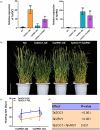The TaSOC1-TaVRN1 module integrates photoperiod and vernalization signals to regulate wheat flowering
- PMID: 37938892
- PMCID: PMC10893938
- DOI: 10.1111/pbi.14211
The TaSOC1-TaVRN1 module integrates photoperiod and vernalization signals to regulate wheat flowering
Abstract
Wheat needs different durations of vernalization, which accelerates flowering by exposure to cold temperature, to ensure reproductive development at the optimum time, as that is critical for adaptability and high yield. TaVRN1 is the central flowering regulator in the vernalization pathway and encodes a MADS-box transcription factor (TF) that usually works by forming hetero- or homo-dimers. We previously identified that TaVRN1 bound to an MADS-box TF TaSOC1 whose orthologues are flowering activators in other plants. The specific function of TaSOC1 and the biological implication of its interaction with TaVRN1 remained unknown. Here, we demonstrated that TaSOC1 was a flowering repressor in the vernalization and photoperiod pathways by overexpression and knockout assays. We confirmed the physical interaction between TaSOC1 and TaVRN1 in wheat protoplasts and in planta, and further validated their genetic interplay. A Flowering Promoting Factor 1-like gene TaFPF1-2B was identified as a common downstream target of TaSOC1 and TaVRN1 through transcriptome and chromatin immunoprecipitation analyses. TaSOC1 competed with TaVRT2, another MADS-box flowering regulator, to bind to TaVRN1; their coding genes synergistically control TaFPF1-2B expression and flowering initiation in response to photoperiod and low temperature. We identified major haplotypes of TaSOC1 and found that TaSOC1-Hap1 conferred earlier flowering than TaSOC1-Hap2 and had been subjected to positive selection in wheat breeding. We also revealed that wheat SOC1 family members were important domestication loci and expanded by tandem and segmental duplication events. These findings offer new insights into the regulatory mechanism underlying flowering control along with useful genetic resources for wheat improvement.
Keywords: Triticum aestivum; TaSOC1; TaVRN1; flowering time; photoperiod; vernalization.
© 2023 The Authors. Plant Biotechnology Journal published by Society for Experimental Biology and The Association of Applied Biologists and John Wiley & Sons Ltd.
Conflict of interest statement
The authors declare no conflicts of interest.
Figures







Similar articles
-
TaVrt2, an SVP-like gene, cooperates with TaVrn1 to regulate vernalization-induced flowering in wheat.New Phytol. 2021 Jul;231(2):834-848. doi: 10.1111/nph.16339. Epub 2019 Dec 28. New Phytol. 2021. PMID: 31769506
-
The vernalization-induced long non-coding RNA VAS functions with the transcription factor TaRF2b to promote TaVRN1 expression for flowering in hexaploid wheat.Mol Plant. 2021 Sep 6;14(9):1525-1538. doi: 10.1016/j.molp.2021.05.026. Epub 2021 May 27. Mol Plant. 2021. PMID: 34052392
-
TaVRT2 represses transcription of the wheat vernalization gene TaVRN1.Plant J. 2007 Aug;51(4):670-80. doi: 10.1111/j.1365-313X.2007.03172.x. Epub 2007 Jun 22. Plant J. 2007. PMID: 17587304
-
Vernalization-mediated chromatin changes.J Exp Bot. 2012 Jul;63(12):4343-8. doi: 10.1093/jxb/ers157. Epub 2012 Jun 8. J Exp Bot. 2012. PMID: 22685309 Review.
-
The molecular basis of vernalization-induced flowering in cereals.Trends Plant Sci. 2007 Aug;12(8):352-7. doi: 10.1016/j.tplants.2007.06.010. Epub 2007 Jul 12. Trends Plant Sci. 2007. PMID: 17629542 Review.
Cited by
-
Molecular genetic regulation of the vegetative-generative transition in wheat from an environmental perspective.Ann Bot. 2025 Mar 13;135(4):605-628. doi: 10.1093/aob/mcae174. Ann Bot. 2025. PMID: 39364537 Free PMC article. Review.
-
Chromatin loops gather targets of upstream regulators together for efficient gene transcription regulation during vernalization in wheat.Genome Biol. 2024 Dec 3;25(1):306. doi: 10.1186/s13059-024-03437-x. Genome Biol. 2024. PMID: 39623466 Free PMC article.
-
MADS-domain transcription factor AGAMOUS LIKE-9 participates in the gibberellin pathway to promote bud dormancy release of tree peony.Hortic Res. 2025 Feb 10;12(5):uhaf043. doi: 10.1093/hr/uhaf043. eCollection 2025 May. Hortic Res. 2025. PMID: 40236736 Free PMC article.
-
Low-Temperature and Light Pretreatment Interactively Promote Rapid Flowering, Early Ripening, and Yield Accumulation of Winter Wheat.Int J Mol Sci. 2025 Apr 30;26(9):4280. doi: 10.3390/ijms26094280. Int J Mol Sci. 2025. PMID: 40362517 Free PMC article.
-
Cloning and functional analysis of ZmMADS42 gene in maize.GM Crops Food. 2024 Dec 31;15(1):105-117. doi: 10.1080/21645698.2024.2328384. Epub 2024 Mar 11. GM Crops Food. 2024. PMID: 38466176 Free PMC article.
References
-
- Borner, R. , Kampmann, G. , Chandler, J. , Gleiûner, R. , Wisman, E. , Ape, K. and Melzer, S. (2000) A MADS domain gene involved in the transition to flowering in Arabidopsis . Plant J. 24, 591–599. - PubMed
-
- Cao, S.H. , Luo, X.M. , Xu, D.A. , Tian, X.L. , Song, J. , Xia, X.C. , Chu, C.C. et al. (2021) Genetic architecture underlying light and temperature mediated flowering in Arabidopsis, rice, and temperate cereals. New Phytol. 230, 1731–1745. - PubMed
MeSH terms
Substances
Associated data
- Actions
- Actions
- Actions
- Actions
Grants and funding
LinkOut - more resources
Full Text Sources
Medical
Research Materials
Miscellaneous

